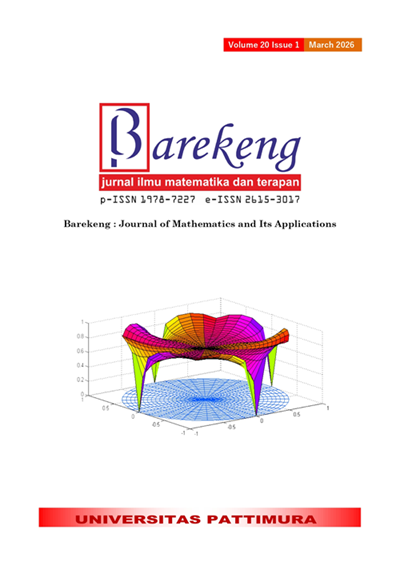COMPARISON OF ARIMA, EXPONENTIAL SMOOTHING, AND CHEN-SINGH FUZZY MODELS FOR INFLATION FORECASTING IN ASEAN COUNTRIES
Abstract
This study aims to (i) develop predictive models using statistical and fuzzy approaches, and (ii) evaluate their forecasting performance. The data were obtained from www.investing.com for the period 1961 to 2017 and focus on five ASEAN countries: Indonesia, Malaysia, the Philippines, Singapore, and Thailand. The statistical models used are Autoregressive Integrated Moving Average (ARIMA) and Exponential Smoothing, while the fuzzy approaches include Chen and Singh fuzzy time series models. The dataset was divided into training and test sets in a 75%-25% proportion. ARIMA models capture trends and autocorrelations in time series data, while Exponential Smoothing uses exponentially weighted averages. Fuzzy models are designed to handle uncertainty and linguistic patterns in data. The results show that Singh’s fuzzy model yields the lowest error for Indonesia, while exponential smoothing and Chen fuzzy time series model demonstrate the same lowest error for Malaysia. For the Philippines, exponential smoothing is most accurate, whereas ARIMA and Singh fuzzy time series achieve the smallest error for Singapore. For Thailand, exponential smoothing and ARIMA perform equally well. However, the robustness of the forecasting model cannot be determined from either statistical or fuzzy methods, highlighting the challenge in determining the most robust model for inflation in the ASEAN region. The 75%-25% data split may also limit the generalizability of the findings. This study contributes a rare cross-country comparison of statistical and fuzzy forecasting methods in the ASEAN context. It highlights the importance of model selection based on country-specific inflation behavior and provides insights for improving forecasting strategies in macroeconomic applications.
Downloads
References
O. Coibion, Y. Gorodnichenko, S. Kumar, and M. Pedemonte, “INFLATION EXPECTATIONS AS A POLICY TOOL?” J. Int. Econ., vol. 124, May 2020. doi: https://doi.org/10.1016/j.jinteco.2020.103297
R. Islam, A. Bashawir, A. Ghani, E. Mahyudin, and N. Manickam, “DETERMINANTS OF FACTORS THAT AFFECT INFLATION IN MALAYSIA,” vol. 7, no. 2, pp. 355–364, 2017.
M. A. Musarat, W. S. Alaloul, and M. S. Liew, “IMPACT OF INFLATION RATE ON CONSTRUCTION PROJECTS BUDGET: A REVIEW,” Mar. 01, 2021, Ain Shams University. doi: https://doi.org/10.1016/j.asej.2020.04.009
M. Azam and S. Khan, “THRESHOLD EFFECTS IN THE RELATIONSHIP BETWEEN INFLATION AND ECONOMIC GROWTH: FURTHER EMPIRICAL EVIDENCE FROM THE DEVELOPED AND DEVELOPING WORLD,” Int. J. Financ. Econ., vol. 27, no. 4, 2022. doi: https://doi.org/10.1002/ijfe.2368
L. Zomchak and A. Lapinkova, “KEY INTEREST RATE AS A CENTRAL BANKS TOOL OF THE MONETARY POLICY INFLUENCE ON INFLATION: THE CASE OF UKRAINE,” in Lecture Notes on Data Engineering and Communications Technologies, vol. 158, 2023. doi: https://doi.org/10.1007/978-3-031-24475-9_32
S. Girdzijauskas, D. Streimikiene, I. Griesiene, A. Mikalauskiene, and G. L. Kyriakopoulos, “NEW APPROACH TO INFLATION PHENOMENA TO ENSURE SUSTAINABLE ECONOMIC GROWTH,” Sustain., vol. 14, no. 1, 2022. doi: https://doi.org/10.3390/su14010518
R. Robiyanto, B. A. Nugroho, E. Handriani, and B. Frensidy, “MEASURING THE EFFECTIVENESS OF ASEAN-5 INITIATIVES FROM EMERGING MARKET PORTFOLIO’S PERSPECTIVE,” Cogent Bus. Manag., vol. 10, no. 1, 2023, doi: https://doi.org/10.1080/23311975.2023.2167292
M. Karl, F. Kock, B. W. Ritchie, and J. Gauss, “AFFECTIVE FORECASTING AND TRAVEL DECISION-MAKING: AN INVESTIGATION IN TIMES OF A PANDEMIC,” Ann. Tour. Res., vol. 87, 2021, doi: https://doi.org/10.1016/j.annals.2021.103139
B. Lim and S. Zohren, “TIME-SERIES FORECASTING WITH DEEP LEARNING: A SURVEY,” 2021. doi: https://doi.org/10.1098/rsta.2020.0209
D. C. Montgomery, C. L. Jennings, and M. Kulahci, INTRODUCTION TO TIME SERIES ANALYSIS AND FORECASTING. Canada: John Wiley & Sons. Inc .. Hoboken. New Jersey., 2015.
I. H. Sarker, “DATA SCIENCE AND ANALYTICS: AN OVERVIEW FROM DATA-DRIVEN SMART COMPUTING, DECISION-MAKING AND APPLICATIONS PERSPECTIVE,” 2021. doi: https://doi.org/10.1007/s42979-021-00765-8
S. Aziz, M. Dowling, H. Hammami, and A. Piepenbrink, “MACHINE LEARNING IN FINANCE: A TOPIC MODELING APPROACH,” Eur. Financ. Manag., vol. 28, no. 3, 2022, doi: https://doi.org/10.1111/eufm.12326
A. Kurani, P. Doshi, A. Vakharia, and M. Shah, “A COMPREHENSIVE COMPARATIVE STUDY OF ARTIFICIAL NEURAL NETWORK (ANN) AND SUPPORT VECTOR MACHINES (SVM) ON STOCK FORECASTING,” 2023. doi: https://doi.org/10.1007/s40745-021-00344-x
F. Petropoulos et al., “FORECASTING: THEORY AND PRACTICE,” Jul. 01, 2022, Elsevier B.V. doi: https://doi.org/10.1016/j.ijforecast.2021.11.001.
H. GRIGORYAN, “STOCK MARKET PREDICTION USING ARTIFICIAL NEURAL NETWORKS. CASE STUDY OF TAL1T, NASDAQ OMX BALTIC STOCk,” pp. 14–23, 2015.
V. Matyushok, V. Krasavina, A. Berezin, and J. S. García, “THE GLOBAL ECONOMY IN TECHNOLOGICAL TRANSFORMATION CONDITIONS: A REVIEW OF MODERN TRENDS,” Econ. Res. Istraz. , vol. 34, no. 1, 2021. doi: https://doi.org/10.1080/1331677X.2020.1844030
G. E. P. Box, G. M. Jenkins, G. C. Reinsel, and G. M. Ljung, TIME SERIES ANALYSIS: FORECASTING AND CONTROL. John Wiley & Sons, 2015.
H. Teichgraeber and A. R. Brandt, “TIME-SERIES AGGREGATION FOR THE OPTIMIZATION OF ENERGY SYSTEMS: GOALS, CHALLENGES, APPROACHES, AND OPPORTUNITIES,” 2022. doi: https://doi.org/10.1016/j.rser.2021.111984
P. B. Weerakody, K. W. Wong, G. Wang, and W. Ela, “A REVIEW OF IRREGULAR TIME SERIES DATA HANDLING WITH GATED RECURRENT NEURAL NETWORKS,” Neurocomputing, vol. 441, 2021. doi: https://doi.org/10.1016/j.neucom.2021.02.046
S. Aras and P. J. G. Lisboa, “EXPLAINABLE INFLATION FORECASTS BY MACHINE LEARNING MODELS,” Expert Syst. Appl., vol. 207, 2022. doi: https://doi.org/10.1016/j.eswa.2022.117982
A. Almosova and N. Andresen, “NONLINEAR INFLATION FORECASTING WITH RECURRENT NEURAL NETWORKS,” J. Forecast., vol. 42, no. 2, 2023. doi: https://doi.org/10.1002/for.2901
O. Barkan, J. Benchimol, I. Caspi, E. Cohen, A. Hammer, and N. Koenigstein, “FORECASTING CPI INFLATION COMPONENTS WITH HIERARCHICAL RECURRENT NEURAL NETWORKS,” Int. J. Forecast., vol. 39, no. 3, 2023. doi: https://doi.org/10.1016/j.ijforecast.2022.04.009
V. I. Kontopoulou, A. D. Panagopoulos, I. Kakkos, and G. K. Matsopoulos, “A REVIEW OF ARIMA VS. MACHINE LEARNING APPROACHES FOR TIME SERIES FORECASTING IN DATA DRIVEN NETWORKS,” 2023. doi: https://doi.org/10.3390/fi15080255
D. Hendrawati, B. W. Dionova, M. I. Abdullah, and D. A. Munawwaroh, “THERMAL COMFORT QUALITY MONITORING AND CONTROLLING USING FUZZY INFERENCE SYSTEM BASED ON IOT TECHNOLOGY.,” Int. J. Adv. Sci. Eng. Inf. Technol., vol. 15, no. 1, 2025. doi: https://doi.org/10.18517/ijaseit.15.1.20334
T. W. Septiarini, M. R. Taufik, and T. A. E. Prasetya, “A COMPARATIVE FORECASTING MODEL OF COVID-19 CASE IN INDONESIA,” in Journal of Physics: Conference Series, IOP Publishing Ltd, Jun. 2021. doi: https://doi.org/10.1088/1742-6596/1918/4/042020
T. W. Septiarini and S. Musikasuwan, “INVESTIGATING THE PERFORMANCE OF ANFIS MODEL TO PREDICT THE HOURLY TEMPERATURE IN PATTANI, THAILAND,” in Journal of Physics: Conference Series, Institute of Physics Publishing, Oct. 2018. doi: https://doi.org/10.1088/1742-6596/1097/1/012085
N. Kumar and S. Susan, “PARTICLE SWARM OPTIMIZATION OF PARTITIONS AND FUZZY ORDER FOR FUZZY TIME SERIES FORECASTING OF COVID-19,” Appl. Soft Comput., vol. 110, 2021. doi: https://doi.org/10.1016/j.asoc.2021.107611
P. Singh, “FQTSFM: A FUZZY-QUANTUM TIME SERIES FORECASTING MODEL,” Inf. Sci. (Ny)., vol. 566, 2021. doi: https://doi.org/10.1016/j.ins.2021.02.024
S. Siami-Namini, N. Tavakoli, and A. Siami Namin, “A COMPARISON OF ARIMA AND LSTM IN FORECASTING TIME SERIES,” in Proceedings - 17th IEEE International Conference on Machine Learning and Applications, ICMLA 2018, 2018. doi: https://doi.org/10.1109/ICMLA.2018.00227
J. Kaur, K. S. Parmar, and S. Singh, “AUTOREGRESSIVE MODELS IN ENVIRONMENTAL FORECASTING TIME SERIES: A THEORETICAL AND APPLICATION REVIEW,” Feb. 01, 2023, Springer Science and Business Media Deutschland GmbH. doi: https://doi.org/10.1007/s11356-023-25148-9
T. W. Septiarini, M. R. Taufik, M. Afif, and A. Rukminastiti Masyrifah, “A COMPARATIVE STUDY FOR BITCOIN CRYPTOCURRENCY FORECASTING IN PERIOD 2017-2019,” in Journal of Physics: Conference Series, Institute of Physics Publishing, Jun. 2020. doi: https://doi.org/10.1088/1742-6596/1511/1/012056
E. Kahraman and O. Akay, “COMPARISON OF EXPONENTIAL SMOOTHING METHODS IN FORECASTING GLOBAL PRICES OF MAIN METALS,” Miner. Econ., vol. 36, no. 3, 2023. doi: https://doi.org/10.1007/s13563-022-00354-y
D. Chicco, M. J. Warrens, and G. Jurman, “THE COEFFICIENT OF DETERMINATION R-SQUARED IS MORE INFORMATIVE THAN SMAPE, MAE, MAPE, MSE AND RMSE IN REGRESSION ANALYSIS EVALUATION,” PeerJ Comput. Sci., vol. 7, 2021. doi: https://doi.org/10.7717/peerj-cs.623
S. Makridakis, E. Spiliotis, and V. Assimakopoulos, “STATISTICAL AND MACHINE LEARNING FORECASTING METHODS: CONCERNS AND WAYS FORWARD,” PLoS One, vol. 13, no. 3, Mar. 2018. doi: https://doi.org/10.1371/journal.pone.0194889
P. Jiang, H. Yang, and J. Heng, “A HYBRID FORECASTING SYSTEM BASED ON FUZZY TIME SERIES AND MULTI-OBJECTIVE OPTIMIZATION FOR WIND SPEED FORECASTING,” Appl. Energy, vol. 235, 2019. doi: https://doi.org/10.1016/j.apenergy.2018.11.012
B. Sarıca, E. Eğrioğlu, and B. Aşıkgil, “A NEW HYBRID METHOD FOR TIME SERIES FORECASTING: AR–ANFIS,” Neural Comput. Appl., vol. 29, no. 3, pp. 749–760, Feb. 2018. doi: https://doi.org/10.1007/s00521-016-2475-5
Copyright (c) 2025 Tri Wijayanti Septiarini, Selly Anastassia Amellia Kharis, Anuraga Jayanegara, Sahidan Abdulmana

This work is licensed under a Creative Commons Attribution-ShareAlike 4.0 International License.
Authors who publish with this Journal agree to the following terms:
- Author retain copyright and grant the journal right of first publication with the work simultaneously licensed under a creative commons attribution license that allow others to share the work within an acknowledgement of the work’s authorship and initial publication of this journal.
- Authors are able to enter into separate, additional contractual arrangement for the non-exclusive distribution of the journal’s published version of the work (e.g. acknowledgement of its initial publication in this journal).
- Authors are permitted and encouraged to post their work online (e.g. in institutional repositories or on their websites) prior to and during the submission process, as it can lead to productive exchanges, as well as earlier and greater citation of published works.






1.gif)



